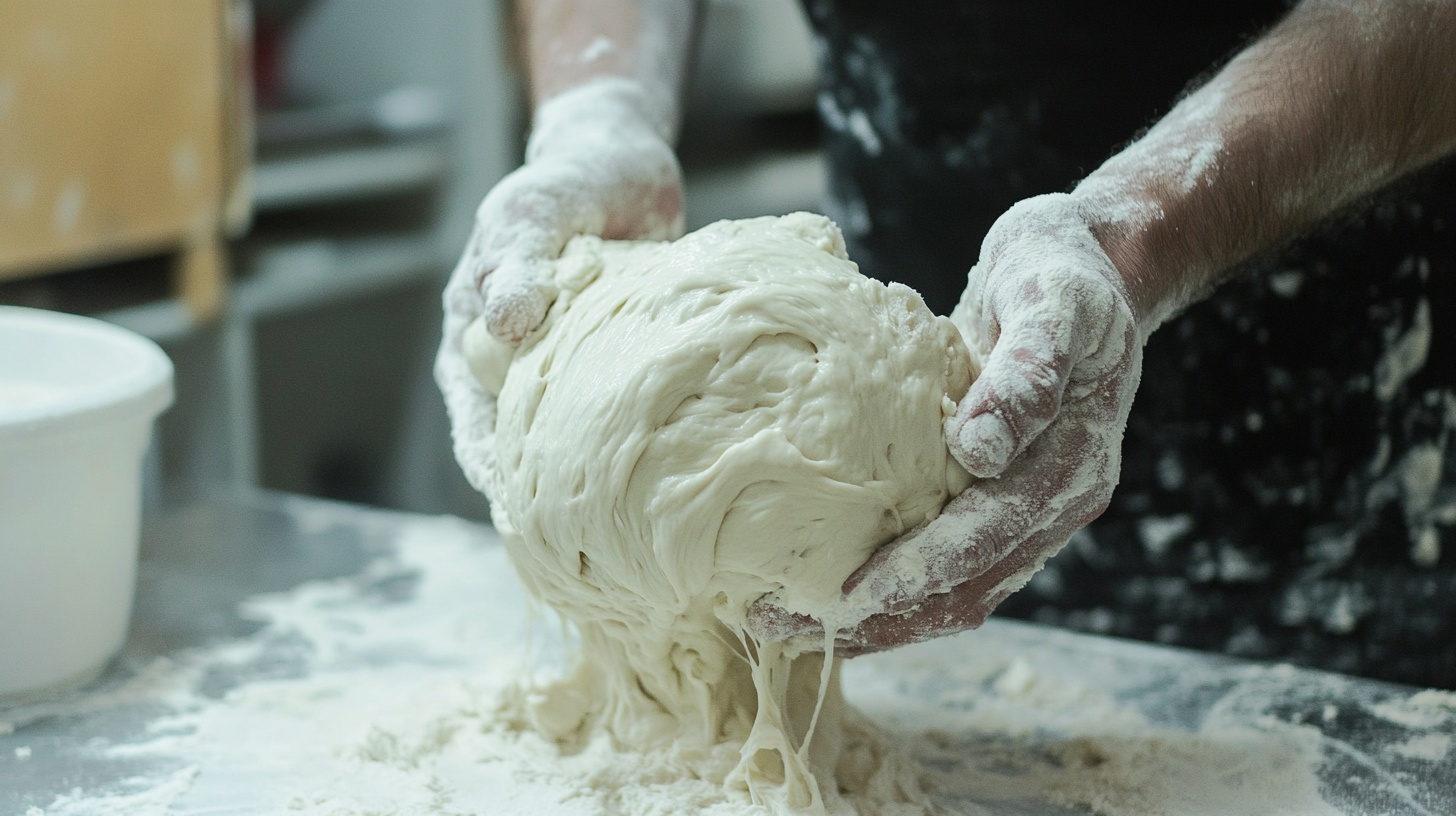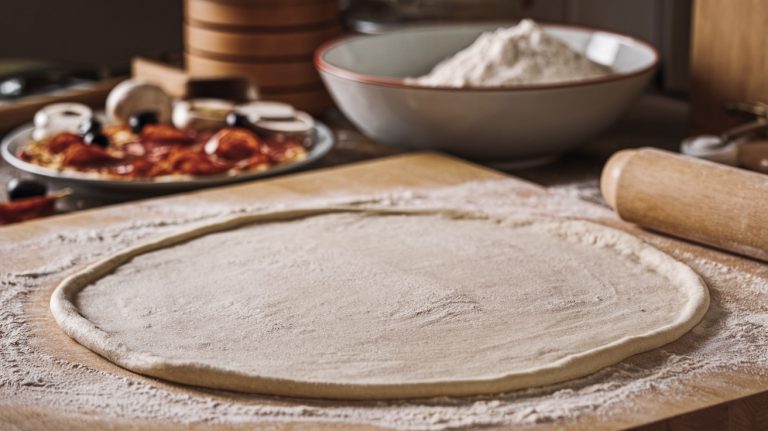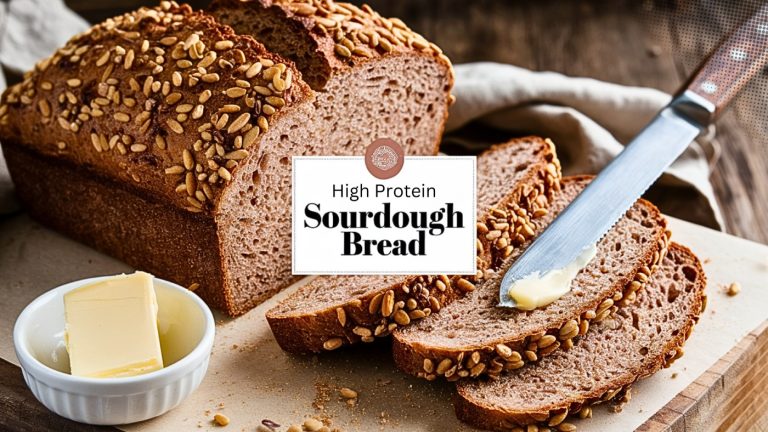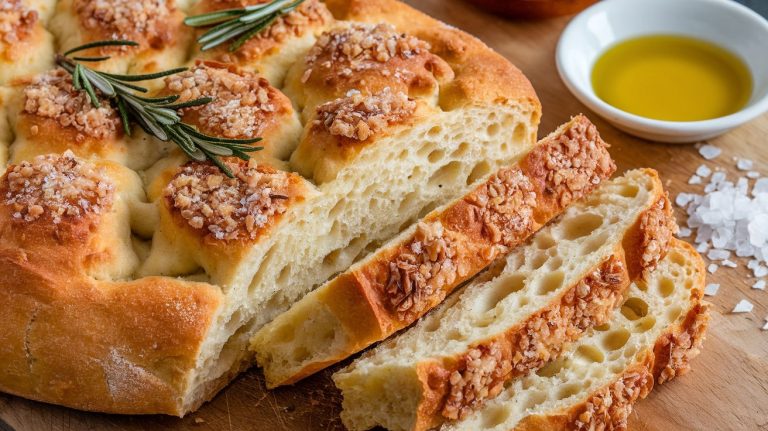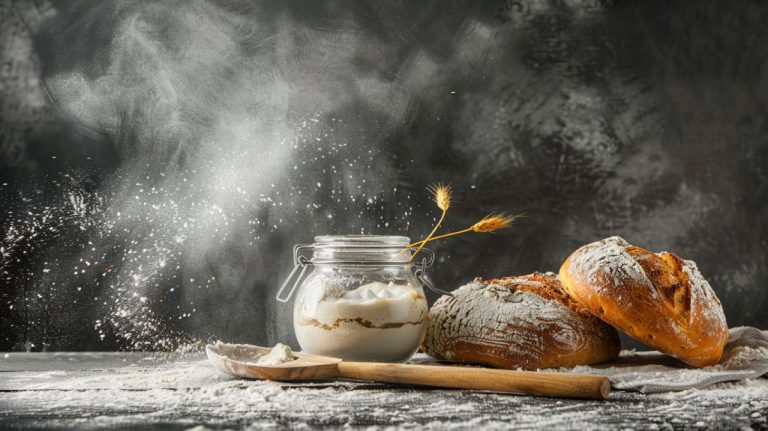Why Is My Sourdough So Sticky: Mess to Crusty Success
Your sourdough’s stickiness likely stems from a few key factors. High hydration levels over 70% create excessively wet dough, while low-protein flours weaken gluten structure, increasing stickiness.
If your dough is over-proofed, it can lose elasticity, resulting in a puddle-like appearance that’s even harder to shape. Reducing water and choosing high-protein flours can help manage hydration.
Incorporating techniques like coil folds during fermentation and allowing resting periods also promote better dough handling. Once you understand these elements, there’s more to exploring about enhancing your sourdough techniques.
Key Takeaways
- High hydration levels over 70% can lead to excessively wet and sticky dough, making it difficult to handle.
- Using low-protein flours creates weak gluten structures, increasing stickiness; opt for flours with 12% protein or higher.
- Warm temperatures and high humidity can amplify stickiness by causing the dough to absorb moisture, complicating handling.
- Over-proofing weakens gluten structure, resulting in excessive stickiness and a puddle-like appearance in the dough.
- Incorporating resting periods and using bench flour can significantly improve dough manageability and reduce stickiness during shaping.
Causes of Sourdough Stickiness
Regarding sourdough stickiness, several key factors can play a role in creating that challenging texture. High hydration levels are often the primary culprit, especially when the water-to-flour ratio exceeds 70%. This excess moisture makes your dough difficult to manage.
Additionally, the type of flour you choose greatly impacts stickiness. Flours with lower protein content, particularly those below 12%, can lead to weaker gluten structures, resulting in a stickier dough.
Monitoring dough consistency during the kneading process is essential to achieve the desired texture. Over-proofing is another critical factor. If you allow your dough to ferment for too long, the gluten structure can weaken, leading to an unmanageable, sticky texture.
Environmental conditions are also essential; warm temperatures and high humidity can amplify stickiness by affecting moisture absorption and fermentation rates.
The Role of Hydration
Hydration levels in your sourdough greatly impact its texture and stickiness. When you use higher hydration ratios, especially above 75%, the dough can become excessively wet and challenging to handle.
This is particularly relevant when considering the importance of gluten development in your dough. Adjusting your water content based on flour type and environmental conditions is essential for achieving the right balance and managing stickiness effectively.
Hydration levels refer to the ratio of water to flour, and for manageable dough, this typically ranges between 65-70%.
At 100% hydration, where water equals the weight of flour, you’ll encounter a very sticky texture that can be challenging to handle. Proper hydration is vital for gluten development factors influencing gluten development, which affects the dough’s elasticity and strength.
Higher hydration can enhance the final loaf’s open crumb structure, but it also requires skill in dough management. The type of flour you choose plays a significant role; higher protein flours, around 12% or more, can absorb more water, aiding gluten development and ultimately affecting the dough’s consistency.
Moreover, environmental factors like temperature and humidity can influence how your dough behaves. In humid conditions, you might find that you need to adjust the water content to maintain the desired texture.
As a result, being mindful of both the hydration level and the flour type you’re using, along with external conditions, is vital for controlling your sourdough’s stickiness and achieving the perfect loaf.
Effects of High Hydration
While many bakers seek the airy, open crumb that high hydration can provide, this approach often comes with challenges. High hydration levels, typically ranging from 70% to 100%, can lead to increased stickiness as water content exceeds flour’s absorption capacity. This stickiness primarily arises from over-hydration, which results in a wet and unmanageable dough texture.
Utilizing digital scales for accurate measurements can help mitigate these issues by ensuring the right balance of ingredients.
Understanding the effects of high hydration is fundamental for effective sourdough baking. Consider the following factors:
- Flour Type: Higher protein flours (12% or more) absorb more water, aiding gluten development and improving dough structure.
- Environmental Conditions: Humidity and temperature can exacerbate stickiness, complicating dough handling.
- Workability: Managing hydration levels is vital for balancing dough elasticity and workability, especially for beginners.
Adjusting Water Content
Managing the water content in your sourdough is essential for achieving the desired dough consistency and final bread quality. The hydration level, defined by the ratio of water to flour, typically ranges from 65-70% for beginner recipes. This range allows for easier handling and minimizes stickiness, which is vital when making sourdough sandwich bread.
If you’re using a higher hydration dough, exceeding 75%, you may find it difficult to manage and shape effectively. To improve workability, consider adjusting the water content by reducing it by 15-25 grams, especially if your flour has a lower protein content.
Different flours absorb water differently; higher protein flours (12% or more) can accommodate more water, enhancing gluten development and reducing stickiness.
Environmental factors like humidity and temperature can also impact your dough’s hydration. In warmer, more humid conditions, your dough may end up wetter than anticipated, requiring you to make further adjustments.
Flour Selection Matters
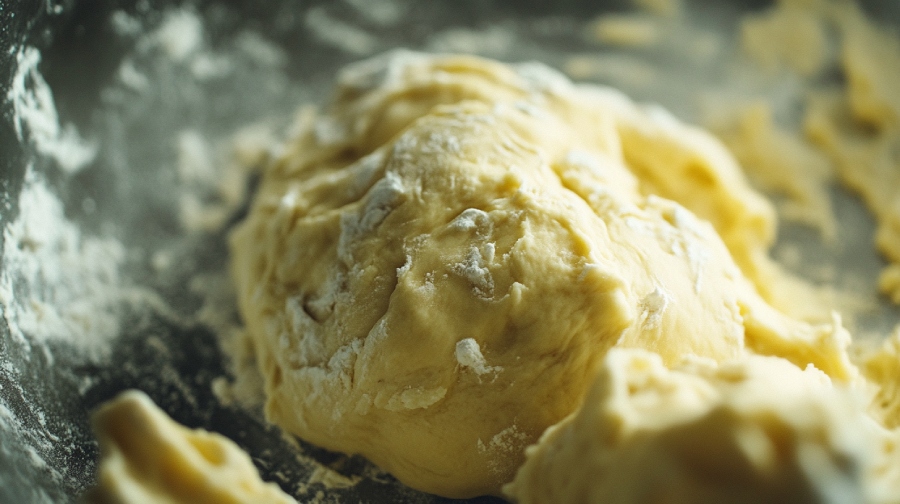
The type of flour you choose plays a vital role in the dough’s texture and stickiness when it comes to sourdough.
Higher protein flours, like bread flour, enhance gluten development, helping you achieve a less sticky consistency.
Conversely, low-protein or all-purpose flours may weaken gluten formation, making the dough more challenging to handle.
Protein Content Importance
Choosing the right flour is essential for achieving the desired texture in your sourdough, as flour with a higher protein content—specifically 12% or more—plays a pivotal role in gluten development. Strong glutenin and gliadin proteins work together to create a robust gluten structure, which helps trap gases and improve the overall texture of your bread.
Here are some key points to reflect on regarding protein content:
- Elasticity and Extensibility: High-protein flours create a dough that’s easier to handle, reducing stickiness while enhancing stretch.
- Moisture Absorption: Higher protein flours can absorb more water without becoming overly sticky, leading to a better crumb structure.
- Blending Options: Combining strong white flour with whole wheat flour can provide the nutritional benefits of whole grains while reinforcing the dough’s strength.
Be mindful of your flour choices; opting for a higher protein content can greatly impact your sourdough’s stickiness and final texture.
Flour Types Comparison
Flour selection greatly influences the quality and texture of your sourdough. Different flours have varying protein contents, which play an essential role in gluten development. Strong bread flour, typically containing 12% or more protein, provides the necessary structure and strength to your dough.
In contrast, whole wheat flour, while nutritious, has a lower gluten-forming capacity, making it less effective for creating a sturdy bread.
When you use high-protein flours, they absorb more water, helping to manage hydration levels. This can considerably reduce stickiness in high-hydration recipes. If you opt for lower protein flours, expect a weaker, stickier dough that can be challenging to handle. This could be the reason your sourdough is problematic.
Experimenting with flour blends can yield better results. Combining strong white flour with whole wheat flour allows you to maintain nutritional benefits while enhancing dough texture and manageability.
The right flour selection not only affects the dough’s ability to hold its shape but also impacts the final bread’s crumb structure and flavor.
Hydration Impact on Dough
Understanding hydration levels is essential for achieving the desired texture and manageability of your sourdough. The hydration ratio, particularly in high-hydration recipes, typically exceeds 70%, which can lead to a stickier dough. Your choice of flour plays a significant role in this outcome.
Consider these factors when selecting flour:
- Protein Content: Higher protein flours (12-13% protein) absorb more water, promoting better gluten development and reducing stickiness.
- Flour Type: Whole wheat flour, while nutritious, usually has lower gluten strength, which can weaken the dough structure and increase stickiness.
- Environmental Conditions: Temperature and humidity influence flour’s capacity to absorb water; warmer conditions can exacerbate stickiness in high-hydration doughs.
Impact of Temperature
The impact of temperature on sourdough stickiness is significant and often underestimated. Higher ambient temperatures can lead to increased enzymatic activity and faster fermentation, causing your dough to become stickier. It’s vital to monitor your dough closely in warm conditions, as fermentation rates can skyrocket, risking over-proofing. When this happens, the gluten structure weakens, and you’re left with an excessively sticky dough.
Typically, the ideal temperature for sourdough fermentation falls between 75°F to 85°F (24°C to 29°C). If you exceed this range, you may encounter unpredictable dough behavior, further exacerbating stickiness. To manage this, consider cooling your dough in the refrigerator for a short period, which slows down fermentation and makes handling much easier.
Additionally, temperature fluctuations during resting or proofing phases can impact moisture retention and overall dough consistency, possibly leading to a sticky texture.
Over-Proofing Effects
When managing sourdough, recognizing the effects of over-proofing is key to maintaining dough quality. Over-proofing occurs when your dough ferments beyond its ideal time, leading to a weakened gluten structure that can result in excessive stickiness.
You’ll notice several signs indicating your dough has been over-proofed:
- A loss of dough strength, making it difficult to shape.
- A puddle-like appearance when placed on a surface, indicating it’s too slack.
- A lack of elasticity causes it to stretch without springing back.
The perfect bulk fermentation time can fluctuate based on temperature, with warmer environments increasing the risk of over-fermentation.
Once your dough is over-proofed, rectifying the issue is tricky. You might find yourself using wet hands or rice flour to manage stickiness during handling.
To prevent this, keep a close watch on your fermentation times and adjust based on your environment.
Handling Techniques
When handling sticky sourdough, mastering techniques like coil folding can greatly enhance your dough’s structure.
You’ll want to pay close attention to your flour and water ratios, as the right balance can mitigate stickiness while promoting gluten development.
Coil Folding Technique
Mastering the coil folding technique can greatly enhance your sourdough’s texture and structure. This method involves gently lifting the dough from the middle and folding it under itself, which helps develop gluten without overly deflating it.
To effectively perform coil folds and reduce stickiness, consider the following tips:
- Wet your hands or apply a small amount of oil to create a non-stick barrier.
- Perform coil folds in sets, allowing a 30-minute resting period between each to let the dough relax.
- After several sets, observe an increase in elasticity and a smoother, firmer surface.
This technique is particularly beneficial for high hydration doughs, as it allows for better handling while minimizing the risk of overworking.
As you incorporate coil folds into your routine, you’ll notice that your dough becomes less sticky and more manageable.
Flour and Water Ratios
Achieving the right flour and water ratios is key to managing the stickiness of your sourdough. The hydration level, or the ratio of water to flour, greatly affects your dough’s texture. Generally, a hydration level of 65-70% yields the most manageable dough. For instance, using 500g of flour with 350g of water results in 70% hydration, while reducing the water to 325g drops it to 65%.
Flour type also matters; higher protein content (12% or more) in bread flour enhances water absorption and gluten development, mitigating stickiness.
Keep in mind that environmental factors like temperature and humidity can change how flour absorbs water, leading to unexpected variations in stickiness even with identical ratios.
If you find your dough too sticky, make gradual adjustments to your ratios. A slight reduction of 15-25g of water can improve handling without drastically affecting hydration levels.
Using Coil Folds
Coil folds can greatly enhance the texture and elasticity of your sourdough, especially when dealing with sticky dough. This gentle handling technique allows you to improve your dough’s structure without overworking it, which can lead to undesired results.
To perform a coil fold effectively, follow these steps:
- Wet your hands to minimize sticking.
- Lift the dough from the middle and fold it underneath itself while turning the bowl.
- Repeat this process for four to six sets, allowing the dough to relax in between.
After each set of coil folds, observe the dough closely. You should notice increased manageability, a glossy surface, and improved firmness, all of which indicate better hydration absorption.
It’s essential to allow a 30-minute resting period after the first set of folds; this time helps the gluten structure develop further.
Continue performing additional sets until your dough reaches the desired consistency.
Resting Period Importance
The importance of resting periods in sourdough preparation can’t be overstated. These intervals allow the dough to hydrate fully, enabling the flour to absorb water effectively. This leads to improved texture and workability, making your sourdough easier to handle.
After each set of coil folds, a 30-minute rest is vital. This time helps relax the gluten, reduce elasticity, and allow for smoother manipulation of the dough.
During these resting phases, you should observe changes in texture. Increased glossiness and firmness indicate progress in gluten development, which is fundamental for a successful loaf. A resting phase of at least 1 hour after the initial mixing gives you a chance to assess stickiness and determine if any adjustments are needed.
Consistent resting intervals throughout the fermentation process contribute considerably to the overall strength and structure of your dough.
Tips for Successful Baking
Achieving successful baking with sourdough hinges on several essential factors that guarantee a well-structured and manageable dough.
First, choose flour with a higher protein content—preferably 12% or more. This enhances gluten development, which strengthens the dough’s structure and reduces stickiness.
Next, monitor your hydration levels closely. Aim for a target hydration of 65-70%, adjusting the water based on the flour type and environmental conditions. This balance is vital for creating a dough you can handle easily.
Incorporate resting periods during the mixing process. Allow the dough a 15-20 minute break to let the flour fully hydrate, making it considerably easier to work with afterward.
Utilize techniques like stretch and folds or coil folds during bulk fermentation.
Frequently Asked Questions
Can I Reduce Stickiness by Adding More Flour During Mixing?
Yes, you can reduce stickiness by adding more flour during mixing. However, do it gradually—about 15-25 grams—to maintain hydration balance. Monitor dough consistency; it should remain slightly tacky but manageable for best results.
How Does My Kitchen’s Altitude Affect Dough Stickiness?
Ever wondered how altitude influences your dough’s texture? At higher elevations, lower pressure and humidity can lead to faster fermentation and less moisture absorption, making your dough stickier. Adjust flour and water amounts for better consistency.
Is Stickiness a Sign of Good Sourdough Fermentation?
Yes, stickiness often indicates good sourdough fermentation. It reflects active yeast development and moisture retention, essential for gluten structure. However, too much stickiness might mean over-fermentation, so verify you monitor your dough closely.
Can I Fix Sticky Dough After It’s Already Mixed?
About 70% of bakers encounter sticky dough at some point. You can fix this by using coil folds, gradually adding flour, or letting it rest. Wet hands help too, reducing stickiness for better handling.
What Tools Are Best for Handling Sticky Sourdough?
To handle sticky sourdough effectively, use a dough scraper for lifting, silicone mats for shaping, a bench knife for cutting, a stand mixer for kneading, and a proofing basket to maintain shape during rising.
Sticky Sourdough? Adjust, Adapt, and Achieve Bread Perfection!
To sum up, if your sourdough’s stickier than a toddler with a candy bar, you might want to reassess your hydration levels, flour choices, and proofing times. Embrace the chaos of dough that resembles a science experiment gone wrong—remember, baking is an art, not a science!
You can turn that sticky mess into a crusty masterpiece with a few adjustments and some patience. After all, who doesn’t love a good challenge when the reward is fresh bread?

